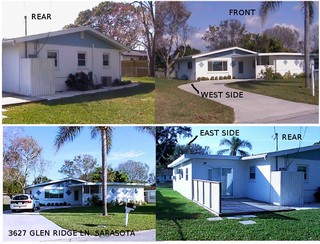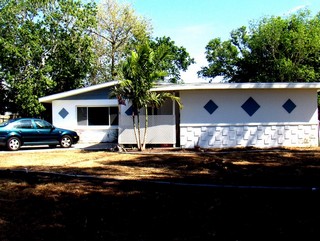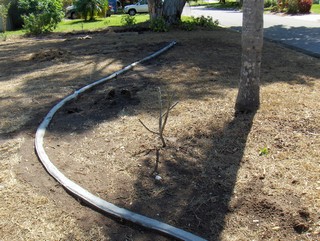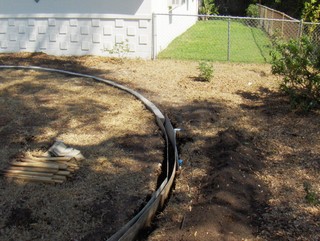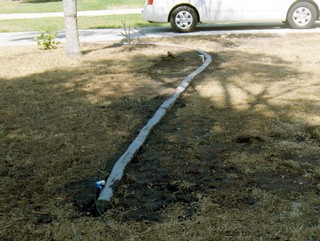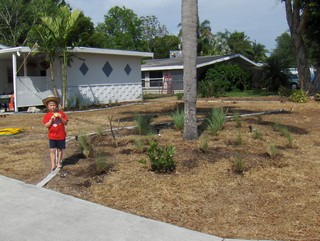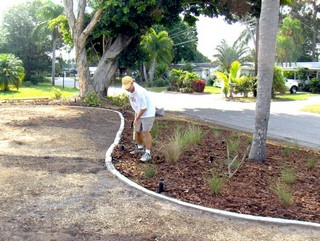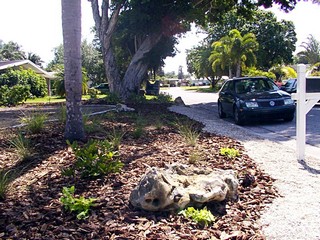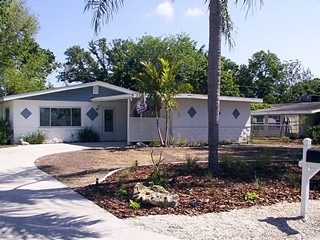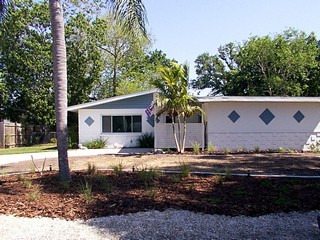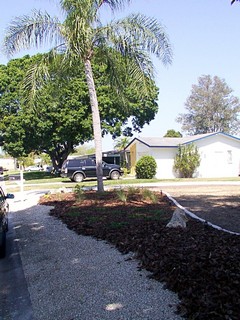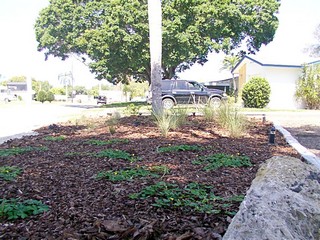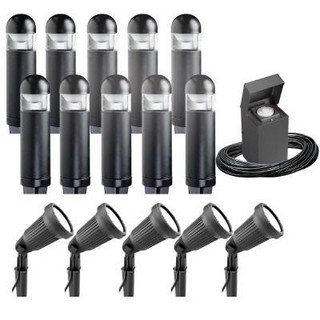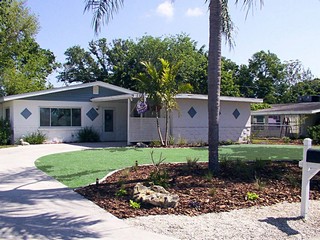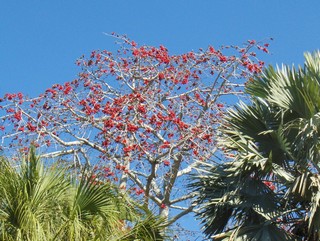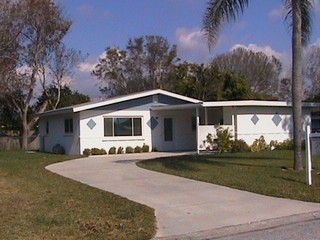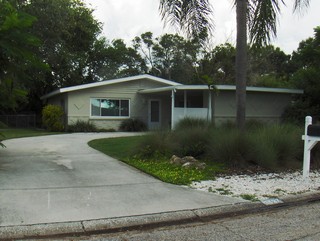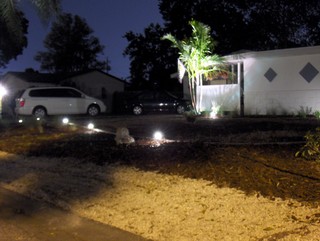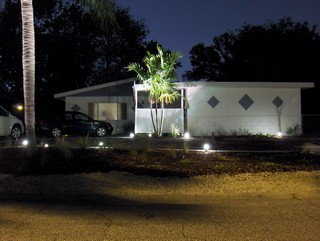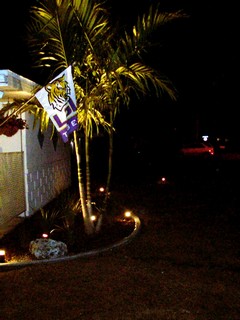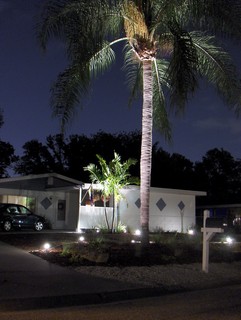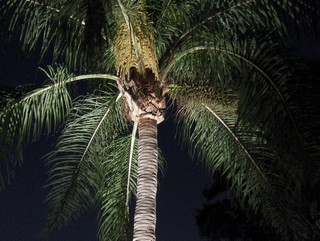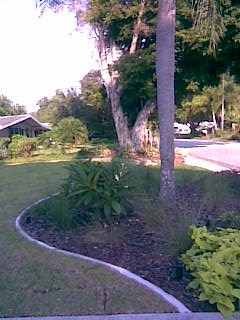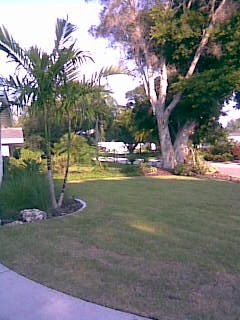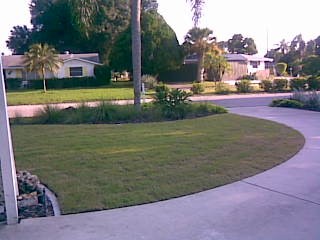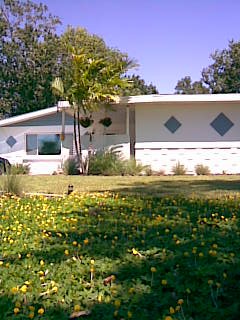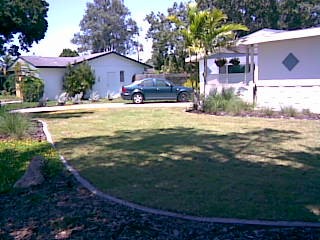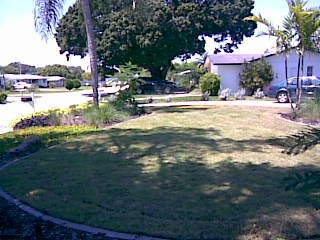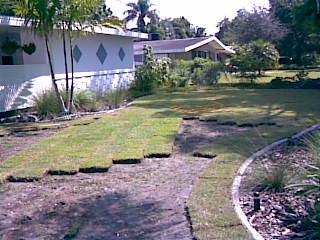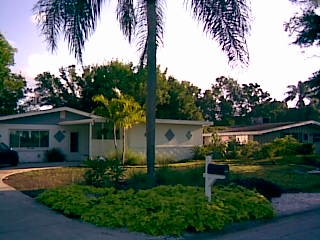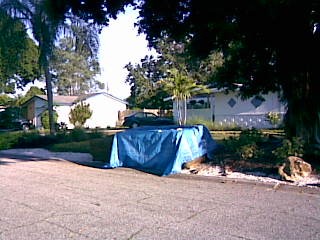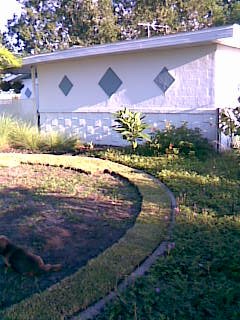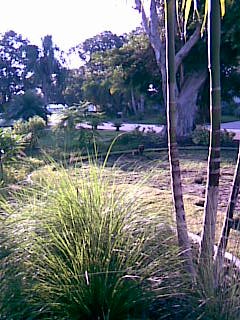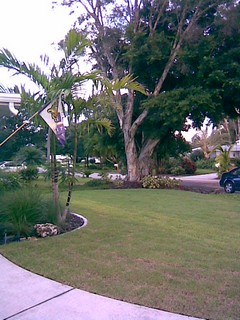My wife and I were homeowners in the Southgate Ridge neighborhood of Sarasota, Florida. It was a typical retiree bungalow repurposed as a starter home located south of downtown and less than five miles from the beach; add another mile if you simply had to continue north to the Siesta Key Beach pavilion. The home was simple, had only one bathroom, but it was paradise. About a year into our ownership, long enough to recover from all of those extra closing costs, we were ready to re-landscape the front yard. This post is a summary of that process.
Existing Conditions
So what were the problems? Essentially it was a nondescript all-grass front yard of very poor quality turf (more weeds than turf) some uninteresting foundation shrubs, a giant ficus tree adjoining my neighbor’s yard and a tall queen palm near the driveway. Our young family had just expanded with our second son, and we wanted both improved street appeal and also a nice plush lawn on which to play with the kids (and our wiener dog.)
Design Development
I worked as a professional designer and planner at a local landscape architectural practice, so I had the tools and reference materials to create a nice design. I’d work on it during lunch or stay a little late some days. Key objectives were to have a smaller area of very high quality, irrigated turf. I wanted more variety and accent shrubs near the house, and an interesting ground cover near the street. Along the street I wanted crushed shell, so that guests parking along the street could easily step out onto the clean shell rather than into sometimes uncut grass. I ended up with a curvilinear border design encircling the turfgrass and making it easy to cut with the mower without any sharp corners. Its placement and proportions also benefited the irrigation system. It needed to be uniform, level, and monolithic. I disliked brick borders because the bricks always shift. I hated plastic or steel borders because they’re too thin and always work out of their level placement. I decided on a poured concrete border described below.
For plants I required interesting, attractive species without water-hungry requirements. Mostly, I chose Florida natives, but a few Florida-friendly species crept into the mix. The turfgrass was “Emerald” zoysia, representing a disease-resistant and drought tolerant alternative to St. Augustine which wouldn’t do so well in full sun anyway unless I poured the water on it. A smaller turf area allowed me to upgrade the species. Zoysia also offered a much finer texture which proved to be much more fun to roll-around on with the kids.
I did repurpose the exotic foundation shrubs to a shady ring around the ficus tree. These grew well in deep shade and provided an interesting height change between the perennial peanut groundcover and the giant tree. For an accent next to the carport I splurged on a tri-stemed tropical palm. It provided an attractive vertical accent next to the house and mimicked the tall queen palm at the street. On the opposite side of the driveway was a narrow grass strip in which I installed a solid low hedge of the native silver buttonwood. This provided a buffer from my other neighbor - Gus - who liked to spend his mornings in a lawn chair in his garage smoking a cigar - in his underwear. Funny guy, and truly dear wife, but everybody has their quirks. They also had a giant old bulldog who would saunter over into my yard each morning to do his business and old-school Gus was the type to just yell at the dog, but not to follow behind with a shovel or baggie. I hoped my hedge would discourage this…but it didn’t.
Irrigation design constraints
I wanted an in-ground, low budget and water conserving irrigation system. I couldn’t afford to install a well and pump for the sprinklers, nor could I purchase a second meter tap at the municipal water line because that would also require tunneling under a wide driveway. I carefully calculated and designed the sprinklers so that the entire system could be run by connecting a hose from the house silcox. The placement of the concrete bed border divided the depth of the yard almost into thirds, so that irrigation nozzles positioned along that border could both completely cover the turf in the middle third, and drip irrigation hoses and misters would cover the shrub and groundcover beds. This also meant that there were zero sprinkler heads or valves within the turf so nothing to hit with the mower, or stub your toe on.
The Concrete Border
At first I thought I’d hire a professional concrete landscape curb installer to come and do the work; then I looked into the cost. It would have consumed my entire budget, and I also disliked the sometimes gaudy colors or patterns. I believed a simple, uniform and level concrete edge approximately 3" wide would be perfect. After further online searches I discovered a do-it-yourself concrete curb system called Kurb. It was nothing but plastic spacers and long smooth flexible plastic forms about 6" wide. Heck, I can do that with a sheet of “door skin” plywood and a bunch of wood stakes plus some spacers to keep the forms uniformly 3" apart. I was also able to form it up in much longer segments that with the over-priced Kurb product. I think I spent about three weekends that fall preparing, excavating, installing the forms, mixing the sackrete, and pouring the curb. Fewer, longer sections of pours also meant fewer seams between sections of the curb. It was hard work, but the result provided a sharp, defined line of separation between the grass and the beds which we found attractive.
Landscape Installation
I began the process in the fall intent on finishing it by spring, in this way avoiding the heat of the summer. Mostly, I was successful, although I recall that fall was slow to cool off so those initial days spent digging out unwanted shrubs, hand-digging trenches for irrigation and lighting cables, and excavating a swath 4 feet wide and 4" deep along the street to accept a bed of crushed oyster shell was tough. But it was my yard so I didn’t mind. The excavated soil (mostly sand) got thrown up onto the center area I was leveling for turf.
Most irrigation plumbing and the night lighting cables were tucked along the shrub bed side of the concrete landscape curb, with one exception of a deeply placed pipe directly across the narrow point of the turf area to reach the shrubs and groundcover bed along the street. In this way no pop-up heads, valve box covers or light fixtures were within the turf area where they’d get damaged by the mower. The spiraling turf spray heads were on the outside of the curb, spraying in across the grass completely covering it.
The Florida native shrubs were purchased from a wholesale nursery out towards Arcadia, and the Emerald zoysia was delivered on a palette by a large area grower who surprisingly had the best price. This happened on separate weekends so I’d have time to get it all installed. I do recall having a surplus of sod which I gave to the associate pastor at my church. He was quite appreciative.
As I completed the landscape installation I received compliments from all of my neighbors and from just about every car that drove by. After a few months as the grass and plants took root and grew the front yard really looked great and we enjoyed many afternoons and evenings chasing the boys, our dog Roux, and sometimes other neighborhood kids around the yard or riding tricycles in the driveway. The irrigation system worked, though it was a manual effort each time to pull the hose across the carport to the connection point and turn the silcox on and off again an hour later. The spiraling sprinkler heads were attractive and fun to watch.
What About the Backyard?
I never did much in the backyard other than plant a Geiger Tree which yielded brilliant orange blooms each spring, and keep the rest of the yard pruned and mowed. There was a large tree at the west side of the yard, providing much appreciated shade each afternoon. This moderated temperatures and prevented the St. Augustine from scorching, so the grass in the backyard was fine as it was. I did try planting a tropical flowering vine along one fence line to provide a screen for the boys wading pool. The first year it looked fantastic, with deep red flowers and glossy foliage. The second and subsequent years it grew like it was on steroids and I’d have to harshly prune it back twice a month - even going onto my neighbor’s side of the fence. Eventually I gave up, sprayed it with an herbicide, and dug it out. I couldn’t control it.
Other Residential Landscape Plans in Florida
- Schlam
- Warfield
- ?
